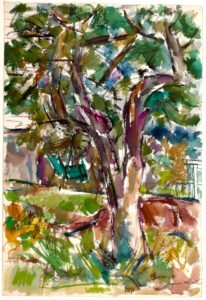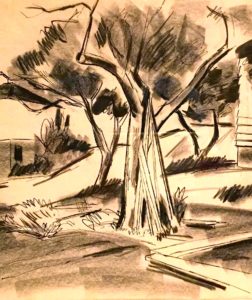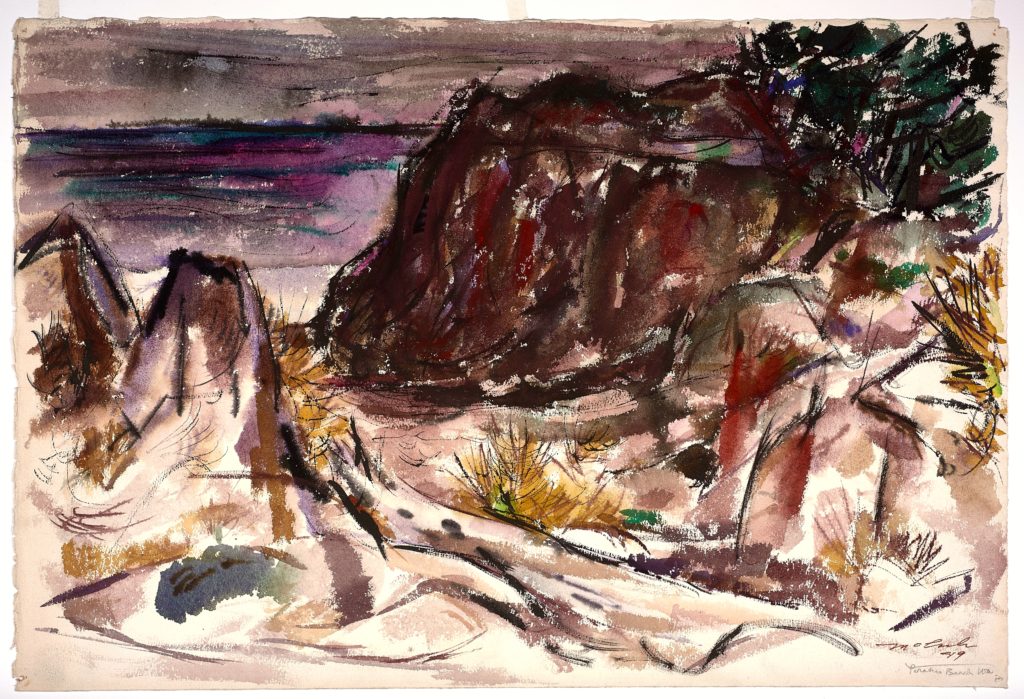(Above: Forest Curtain, by Northwest painter David McCosh, shows his ability to separate a landscape into its layers of line, color, and depth.)
By Randi Bjornstad
Taking in a solo art show simply by steeping yourself in an array of paintings by a single fine artist can be a delight in itself, but it’s even more special if you know a bit more about who the person was and how that singular outlook inspired what you see on the walls.
That’s the case with a new show, Entanglements, which opens Sept. 5 at the Karin Clarke Gallery. It’s not the first time that Clarke has offered David McCosh’s paintings to her gallerygoers, but when art aficionado and collector Roger Saydack curates an exhibit, there’s much more to be seen than meets the eye.
Although he never met McCosh personally — the artist was born in Iowa in 1903 and died in 1981 — Saydack, a longtime business attorney in Eugene, has made a close study of the artist and his stylistic trajectory.
“There’s so much that is special about McCosh,” he said. “In the early 1930s, he was living in Chicago, and because of that environment, he painted a lot of people, some lonely, some happy. Then when he came to teach at the University of Oregon in 1934, he was struck by the immensity of the landscape here. Eugene in particular fascinated him with its mix of country and city.”
By the late 1940s, McCosh had been making a name for himself in the art world, but he was not satisfied with what he had achieved, Saydack said.
“He took a sabbatical from the UO in 1949-50, and he went to a cabin that another UO faculty member had at Cohasset Beach, Wash. His wife (Anne Kutka McCosh) told me that he kind of started all over there — in kind of a primitive way — looking at all the things the tide washed up. He would pick up a stick, dip it in paint and use it on canvas to capture the primitive aspect of what he was seeing.”
The last months of the sabbatical included a trip to Mexico, where its vivid colors, shapes, and light qualities startled McCosh’s sensibilities over again.

McCosh discerned the basic elements of what he saw (see right image) to share the essence of what he saw

Identifying the skeletal structure of the apple tree enabled McCosh to know how to paint it in its greater reality (see left image)
“That was all totally new to him, Saydack said. “He said a lot of what he did before that was what he knew. After that, he knew he wanted to know how he knew what he knew.”
And that’s what people will see in the new McCosh show, which includes 26 paintings by the artist, Saydack said. “These paintings together analyze what is happening within his art — its roots, growth, and energy — with the idea of showing exactly the way he was seeing what he was painting, what the essence of the subject really was.”
“That’s when he began to focus in on details that he saw in clumps of vegetation instead of simply painting a generalized outdoor scene,” he said. “That’s when his work became deeper, when he started to paint how he knew what he knew, instead of just recording an overall impression.”
In Saydack’s view, McCosh, who died after a decade-long deterioration from amyotrophic lateral sclerosis, also called Lou Gehrig’s disease, deserves a far wider repute than what he achieved.
“He is very well-known regionally, but he never had a dealer to promote his work, so he is not as recognized as he might be otherwise,” Saydack said. “But fame was not his purpose — he cared much more about doing art than showing it. He was not one who tried to make sure that he was widely known.
“He preferred to be called a painter, not an artist.”
Saydack has written a book about McCosh, titled Learning to Paint is Learning to See. It will be available for sale at the gallery during the exhibit.
Entanglements
When: Sept. 4 through Sept. 28, with an opening reception from 5:30 p.m. to 7:30 p.m. on Friday, Sept. 5
Where: Karin Clarke Gallery, 760 Willamette St., Eugene
Regular gallery hours: Noon to 5:30 p.m. Wednesday through Friday, 10 a.m. to 4 p.m. Saturday
Information: 541-684-7963, karinclarkegallery.com

David McCosh’s early painting of Paradise Beach in Washington State shows his style before he developed his talent for deconstructing a scene into its fundamental elements in order to paint it exactly as he saw it.












